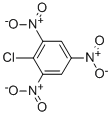Trinitrochlorobenzene (picryl chloride), wetted, with not less than 10% water by mass is a white to yellow moist mass of crystals or a slurry. An explosive, but wetting lowers the risk of detonation. Dangerously explosive if allowed to dry out. The dry compound melts at 83-85°C, is denser than water and is insoluble in water. May be toxic by ingestion. Store tightly sealed (to protect from drying out) in a cool, ventilated place, away from acute fire hazards and easily oxidized materials. May be irritating to skin and mucous membranes.
Trinitrochlorobenzene (picryl chloride 28260-61-9), wetted, with not less than 10% water by mass is a desensitized high explosive. Burns but may be difficult to ignite. Emits toxic fumes of NOx and explodes when heated to decomposition. Forms unstable salts with concrete, ammonia, bases and metals, particularly copper, lead and zinc. Incompatible with reducing agents and bases, and can explode upon immediate contact with such materials. Incompatible with oxidizing agents such as chlorates and nitrates.
Some are toxic and may be fatal if inhaled, swallowed or absorbed through skin. Contact may cause burns to skin and eyes. Fire may produce irritating, corrosive and/or toxic gases. Runoff from fire control or dilution water may cause pollution.
Mutation data reported.
An explosive. When heated to
decomposition it emits toxic fumes of Cl-
NOx. See also NITRO COMPOUNDS
of AROMATIC HYDROCARBONS and
EXPLOSIVES, HIGH.
